Conflict Escalation: Interpersonal Conflict and Workplace Bullying
VerifiedAdded on 2023/06/04
|22
|8520
|472
AI Summary
This research paper investigates the relationship between interpersonal conflict and workplace bullying, examining the role of conflict management styles in this dynamic. The study, based on a survey of 761 employees in Spain, suggests that the escalation of task-related conflict to relationship conflict can contribute to bullying situations. Problem-solving conflict management styles may prevent this escalation, while forcing, yielding, and avoiding styles may exacerbate it. The research hypothesizes that relationship conflict mediates the effect of task conflict on workplace bullying and that conflict management styles moderate this mediation. The findings highlight the importance of effective conflict management in preventing workplace bullying, offering valuable insights for managers and occupational health practitioners. The paper also acknowledges limitations, such as the correlational design, and suggests future research to further explore the dynamic conflict process.
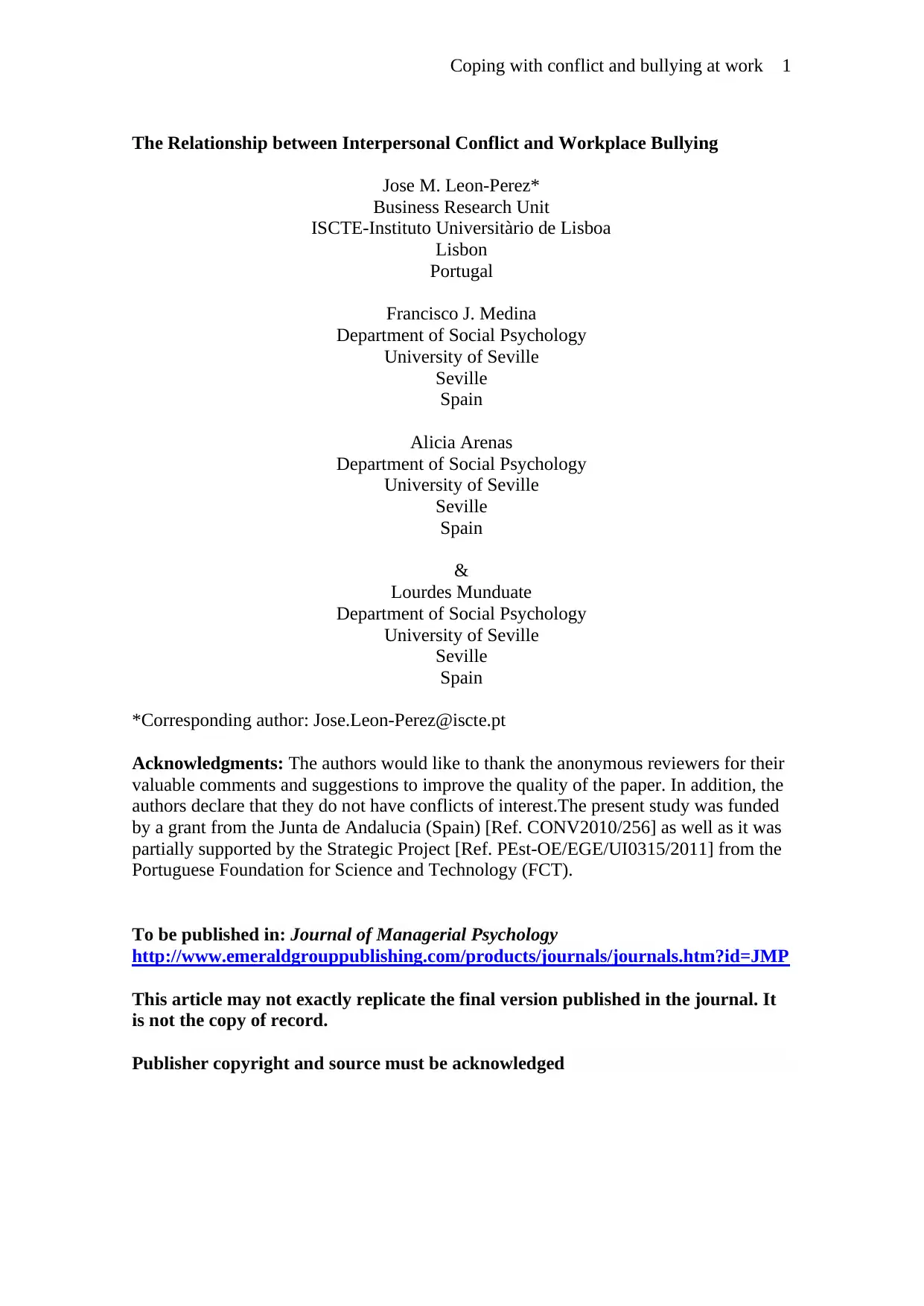
Coping with conflict and bullying at work 1
The Relationship between Interpersonal Conflict and Workplace Bullying
Jose M. Leon-Perez*
Business Research Unit
ISCTE-Instituto Universitàrio de Lisboa
Lisbon
Portugal
Francisco J. Medina
Department of Social Psychology
University of Seville
Seville
Spain
Alicia Arenas
Department of Social Psychology
University of Seville
Seville
Spain
&
Lourdes Munduate
Department of Social Psychology
University of Seville
Seville
Spain
*Corresponding author: Jose.Leon-Perez@iscte.pt
Acknowledgments: The authors would like to thank the anonymous reviewers for their
valuable comments and suggestions to improve the quality of the paper. In addition, the
authors declare that they do not have conflicts of interest.The present study was funded
by a grant from the Junta de Andalucia (Spain) [Ref. CONV2010/256] as well as it was
partially supported by the Strategic Project [Ref. PEst-OE/EGE/UI0315/2011] from the
Portuguese Foundation for Science and Technology (FCT).
To be published in: Journal of Managerial Psychology
http://www.emeraldgrouppublishing.com/products/journals/journals.htm?id=JMP
This article may not exactly replicate the final version published in the journal. It
is not the copy of record.
Publisher copyright and source must be acknowledged
The Relationship between Interpersonal Conflict and Workplace Bullying
Jose M. Leon-Perez*
Business Research Unit
ISCTE-Instituto Universitàrio de Lisboa
Lisbon
Portugal
Francisco J. Medina
Department of Social Psychology
University of Seville
Seville
Spain
Alicia Arenas
Department of Social Psychology
University of Seville
Seville
Spain
&
Lourdes Munduate
Department of Social Psychology
University of Seville
Seville
Spain
*Corresponding author: Jose.Leon-Perez@iscte.pt
Acknowledgments: The authors would like to thank the anonymous reviewers for their
valuable comments and suggestions to improve the quality of the paper. In addition, the
authors declare that they do not have conflicts of interest.The present study was funded
by a grant from the Junta de Andalucia (Spain) [Ref. CONV2010/256] as well as it was
partially supported by the Strategic Project [Ref. PEst-OE/EGE/UI0315/2011] from the
Portuguese Foundation for Science and Technology (FCT).
To be published in: Journal of Managerial Psychology
http://www.emeraldgrouppublishing.com/products/journals/journals.htm?id=JMP
This article may not exactly replicate the final version published in the journal. It
is not the copy of record.
Publisher copyright and source must be acknowledged
Paraphrase This Document
Need a fresh take? Get an instant paraphrase of this document with our AI Paraphraser
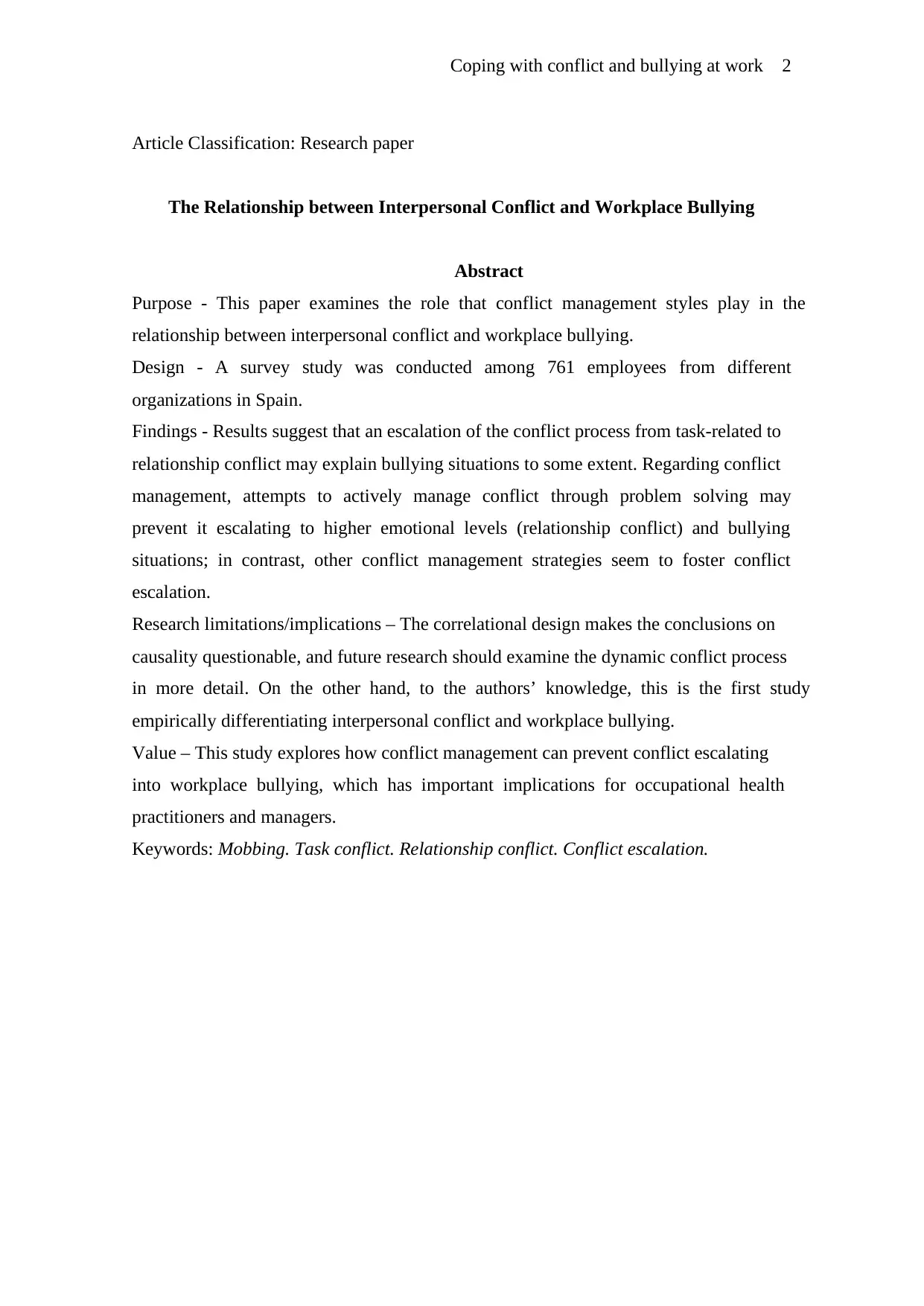
Coping with conflict and bullying at work 2
Article Classification: Research paper
The Relationship between Interpersonal Conflict and Workplace Bullying
Abstract
Purpose - This paper examines the role that conflict management styles play in the
relationship between interpersonal conflict and workplace bullying.
Design - A survey study was conducted among 761 employees from different
organizations in Spain.
Findings - Results suggest that an escalation of the conflict process from task-related to
relationship conflict may explain bullying situations to some extent. Regarding conflict
management, attempts to actively manage conflict through problem solving may
prevent it escalating to higher emotional levels (relationship conflict) and bullying
situations; in contrast, other conflict management strategies seem to foster conflict
escalation.
Research limitations/implications – The correlational design makes the conclusions on
causality questionable, and future research should examine the dynamic conflict process
in more detail. On the other hand, to the authors’ knowledge, this is the first study
empirically differentiating interpersonal conflict and workplace bullying.
Value – This study explores how conflict management can prevent conflict escalating
into workplace bullying, which has important implications for occupational health
practitioners and managers.
Keywords: Mobbing. Task conflict. Relationship conflict. Conflict escalation.
Article Classification: Research paper
The Relationship between Interpersonal Conflict and Workplace Bullying
Abstract
Purpose - This paper examines the role that conflict management styles play in the
relationship between interpersonal conflict and workplace bullying.
Design - A survey study was conducted among 761 employees from different
organizations in Spain.
Findings - Results suggest that an escalation of the conflict process from task-related to
relationship conflict may explain bullying situations to some extent. Regarding conflict
management, attempts to actively manage conflict through problem solving may
prevent it escalating to higher emotional levels (relationship conflict) and bullying
situations; in contrast, other conflict management strategies seem to foster conflict
escalation.
Research limitations/implications – The correlational design makes the conclusions on
causality questionable, and future research should examine the dynamic conflict process
in more detail. On the other hand, to the authors’ knowledge, this is the first study
empirically differentiating interpersonal conflict and workplace bullying.
Value – This study explores how conflict management can prevent conflict escalating
into workplace bullying, which has important implications for occupational health
practitioners and managers.
Keywords: Mobbing. Task conflict. Relationship conflict. Conflict escalation.
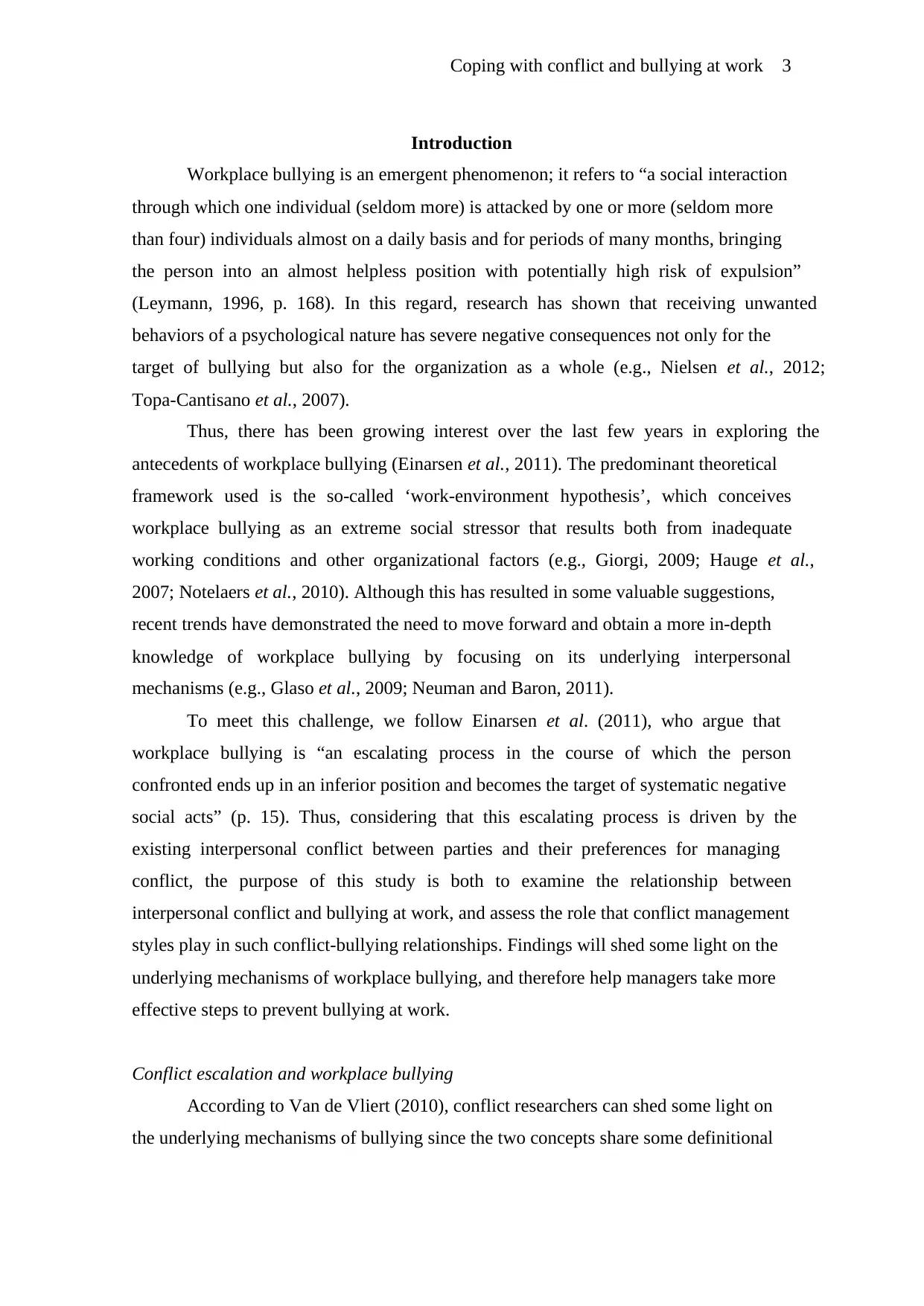
Coping with conflict and bullying at work 3
Introduction
Workplace bullying is an emergent phenomenon; it refers to “a social interaction
through which one individual (seldom more) is attacked by one or more (seldom more
than four) individuals almost on a daily basis and for periods of many months, bringing
the person into an almost helpless position with potentially high risk of expulsion”
(Leymann, 1996, p. 168). In this regard, research has shown that receiving unwanted
behaviors of a psychological nature has severe negative consequences not only for the
target of bullying but also for the organization as a whole (e.g., Nielsen et al., 2012;
Topa-Cantisano et al., 2007).
Thus, there has been growing interest over the last few years in exploring the
antecedents of workplace bullying (Einarsen et al., 2011). The predominant theoretical
framework used is the so-called ‘work-environment hypothesis’, which conceives
workplace bullying as an extreme social stressor that results both from inadequate
working conditions and other organizational factors (e.g., Giorgi, 2009; Hauge et al.,
2007; Notelaers et al., 2010). Although this has resulted in some valuable suggestions,
recent trends have demonstrated the need to move forward and obtain a more in-depth
knowledge of workplace bullying by focusing on its underlying interpersonal
mechanisms (e.g., Glaso et al., 2009; Neuman and Baron, 2011).
To meet this challenge, we follow Einarsen et al. (2011), who argue that
workplace bullying is “an escalating process in the course of which the person
confronted ends up in an inferior position and becomes the target of systematic negative
social acts” (p. 15). Thus, considering that this escalating process is driven by the
existing interpersonal conflict between parties and their preferences for managing
conflict, the purpose of this study is both to examine the relationship between
interpersonal conflict and bullying at work, and assess the role that conflict management
styles play in such conflict-bullying relationships. Findings will shed some light on the
underlying mechanisms of workplace bullying, and therefore help managers take more
effective steps to prevent bullying at work.
Conflict escalation and workplace bullying
According to Van de Vliert (2010), conflict researchers can shed some light on
the underlying mechanisms of bullying since the two concepts share some definitional
Introduction
Workplace bullying is an emergent phenomenon; it refers to “a social interaction
through which one individual (seldom more) is attacked by one or more (seldom more
than four) individuals almost on a daily basis and for periods of many months, bringing
the person into an almost helpless position with potentially high risk of expulsion”
(Leymann, 1996, p. 168). In this regard, research has shown that receiving unwanted
behaviors of a psychological nature has severe negative consequences not only for the
target of bullying but also for the organization as a whole (e.g., Nielsen et al., 2012;
Topa-Cantisano et al., 2007).
Thus, there has been growing interest over the last few years in exploring the
antecedents of workplace bullying (Einarsen et al., 2011). The predominant theoretical
framework used is the so-called ‘work-environment hypothesis’, which conceives
workplace bullying as an extreme social stressor that results both from inadequate
working conditions and other organizational factors (e.g., Giorgi, 2009; Hauge et al.,
2007; Notelaers et al., 2010). Although this has resulted in some valuable suggestions,
recent trends have demonstrated the need to move forward and obtain a more in-depth
knowledge of workplace bullying by focusing on its underlying interpersonal
mechanisms (e.g., Glaso et al., 2009; Neuman and Baron, 2011).
To meet this challenge, we follow Einarsen et al. (2011), who argue that
workplace bullying is “an escalating process in the course of which the person
confronted ends up in an inferior position and becomes the target of systematic negative
social acts” (p. 15). Thus, considering that this escalating process is driven by the
existing interpersonal conflict between parties and their preferences for managing
conflict, the purpose of this study is both to examine the relationship between
interpersonal conflict and bullying at work, and assess the role that conflict management
styles play in such conflict-bullying relationships. Findings will shed some light on the
underlying mechanisms of workplace bullying, and therefore help managers take more
effective steps to prevent bullying at work.
Conflict escalation and workplace bullying
According to Van de Vliert (2010), conflict researchers can shed some light on
the underlying mechanisms of bullying since the two concepts share some definitional
⊘ This is a preview!⊘
Do you want full access?
Subscribe today to unlock all pages.

Trusted by 1+ million students worldwide
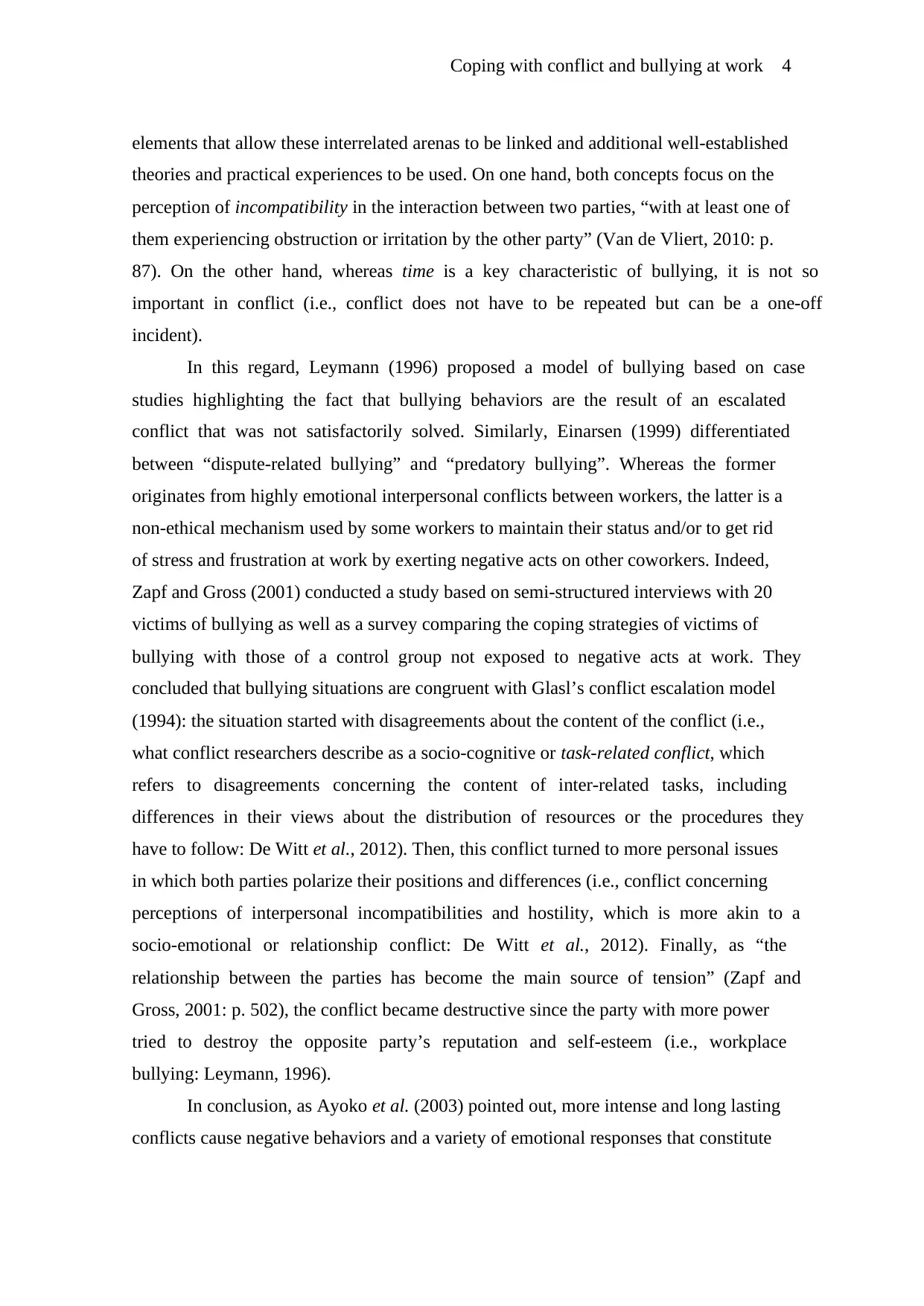
Coping with conflict and bullying at work 4
elements that allow these interrelated arenas to be linked and additional well-established
theories and practical experiences to be used. On one hand, both concepts focus on the
perception of incompatibility in the interaction between two parties, “with at least one of
them experiencing obstruction or irritation by the other party” (Van de Vliert, 2010: p.
87). On the other hand, whereas time is a key characteristic of bullying, it is not so
important in conflict (i.e., conflict does not have to be repeated but can be a one-off
incident).
In this regard, Leymann (1996) proposed a model of bullying based on case
studies highlighting the fact that bullying behaviors are the result of an escalated
conflict that was not satisfactorily solved. Similarly, Einarsen (1999) differentiated
between “dispute-related bullying” and “predatory bullying”. Whereas the former
originates from highly emotional interpersonal conflicts between workers, the latter is a
non-ethical mechanism used by some workers to maintain their status and/or to get rid
of stress and frustration at work by exerting negative acts on other coworkers. Indeed,
Zapf and Gross (2001) conducted a study based on semi-structured interviews with 20
victims of bullying as well as a survey comparing the coping strategies of victims of
bullying with those of a control group not exposed to negative acts at work. They
concluded that bullying situations are congruent with Glasl’s conflict escalation model
(1994): the situation started with disagreements about the content of the conflict (i.e.,
what conflict researchers describe as a socio-cognitive or task-related conflict, which
refers to disagreements concerning the content of inter-related tasks, including
differences in their views about the distribution of resources or the procedures they
have to follow: De Witt et al., 2012). Then, this conflict turned to more personal issues
in which both parties polarize their positions and differences (i.e., conflict concerning
perceptions of interpersonal incompatibilities and hostility, which is more akin to a
socio-emotional or relationship conflict: De Witt et al., 2012). Finally, as “the
relationship between the parties has become the main source of tension” (Zapf and
Gross, 2001: p. 502), the conflict became destructive since the party with more power
tried to destroy the opposite party’s reputation and self-esteem (i.e., workplace
bullying: Leymann, 1996).
In conclusion, as Ayoko et al. (2003) pointed out, more intense and long lasting
conflicts cause negative behaviors and a variety of emotional responses that constitute
elements that allow these interrelated arenas to be linked and additional well-established
theories and practical experiences to be used. On one hand, both concepts focus on the
perception of incompatibility in the interaction between two parties, “with at least one of
them experiencing obstruction or irritation by the other party” (Van de Vliert, 2010: p.
87). On the other hand, whereas time is a key characteristic of bullying, it is not so
important in conflict (i.e., conflict does not have to be repeated but can be a one-off
incident).
In this regard, Leymann (1996) proposed a model of bullying based on case
studies highlighting the fact that bullying behaviors are the result of an escalated
conflict that was not satisfactorily solved. Similarly, Einarsen (1999) differentiated
between “dispute-related bullying” and “predatory bullying”. Whereas the former
originates from highly emotional interpersonal conflicts between workers, the latter is a
non-ethical mechanism used by some workers to maintain their status and/or to get rid
of stress and frustration at work by exerting negative acts on other coworkers. Indeed,
Zapf and Gross (2001) conducted a study based on semi-structured interviews with 20
victims of bullying as well as a survey comparing the coping strategies of victims of
bullying with those of a control group not exposed to negative acts at work. They
concluded that bullying situations are congruent with Glasl’s conflict escalation model
(1994): the situation started with disagreements about the content of the conflict (i.e.,
what conflict researchers describe as a socio-cognitive or task-related conflict, which
refers to disagreements concerning the content of inter-related tasks, including
differences in their views about the distribution of resources or the procedures they
have to follow: De Witt et al., 2012). Then, this conflict turned to more personal issues
in which both parties polarize their positions and differences (i.e., conflict concerning
perceptions of interpersonal incompatibilities and hostility, which is more akin to a
socio-emotional or relationship conflict: De Witt et al., 2012). Finally, as “the
relationship between the parties has become the main source of tension” (Zapf and
Gross, 2001: p. 502), the conflict became destructive since the party with more power
tried to destroy the opposite party’s reputation and self-esteem (i.e., workplace
bullying: Leymann, 1996).
In conclusion, as Ayoko et al. (2003) pointed out, more intense and long lasting
conflicts cause negative behaviors and a variety of emotional responses that constitute
Paraphrase This Document
Need a fresh take? Get an instant paraphrase of this document with our AI Paraphraser
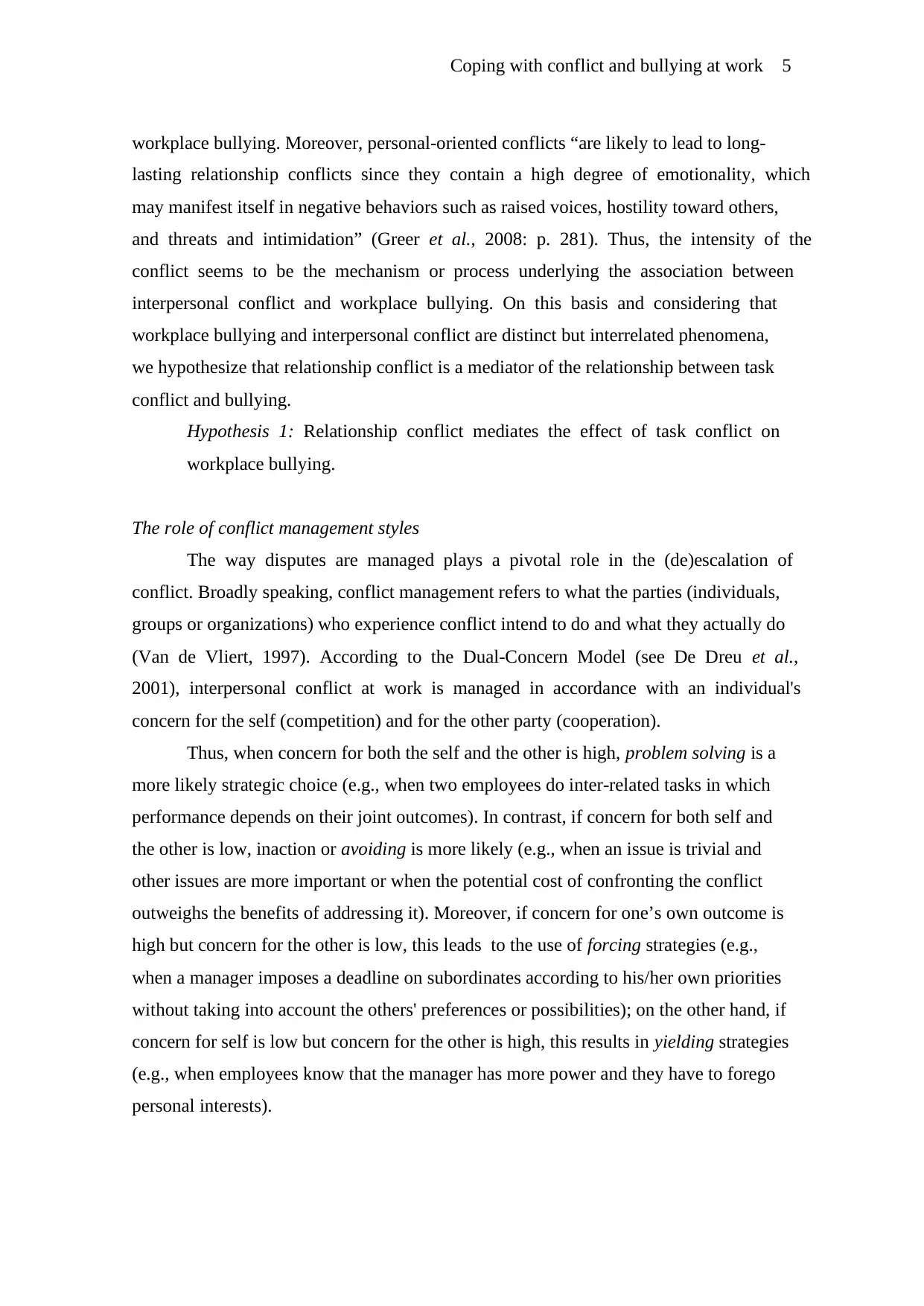
Coping with conflict and bullying at work 5
workplace bullying. Moreover, personal-oriented conflicts “are likely to lead to long-
lasting relationship conflicts since they contain a high degree of emotionality, which
may manifest itself in negative behaviors such as raised voices, hostility toward others,
and threats and intimidation” (Greer et al., 2008: p. 281). Thus, the intensity of the
conflict seems to be the mechanism or process underlying the association between
interpersonal conflict and workplace bullying. On this basis and considering that
workplace bullying and interpersonal conflict are distinct but interrelated phenomena,
we hypothesize that relationship conflict is a mediator of the relationship between task
conflict and bullying.
Hypothesis 1: Relationship conflict mediates the effect of task conflict on
workplace bullying.
The role of conflict management styles
The way disputes are managed plays a pivotal role in the (de)escalation of
conflict. Broadly speaking, conflict management refers to what the parties (individuals,
groups or organizations) who experience conflict intend to do and what they actually do
(Van de Vliert, 1997). According to the Dual-Concern Model (see De Dreu et al.,
2001), interpersonal conflict at work is managed in accordance with an individual's
concern for the self (competition) and for the other party (cooperation).
Thus, when concern for both the self and the other is high, problem solving is a
more likely strategic choice (e.g., when two employees do inter-related tasks in which
performance depends on their joint outcomes). In contrast, if concern for both self and
the other is low, inaction or avoiding is more likely (e.g., when an issue is trivial and
other issues are more important or when the potential cost of confronting the conflict
outweighs the benefits of addressing it). Moreover, if concern for one’s own outcome is
high but concern for the other is low, this leads to the use of forcing strategies (e.g.,
when a manager imposes a deadline on subordinates according to his/her own priorities
without taking into account the others' preferences or possibilities); on the other hand, if
concern for self is low but concern for the other is high, this results in yielding strategies
(e.g., when employees know that the manager has more power and they have to forego
personal interests).
workplace bullying. Moreover, personal-oriented conflicts “are likely to lead to long-
lasting relationship conflicts since they contain a high degree of emotionality, which
may manifest itself in negative behaviors such as raised voices, hostility toward others,
and threats and intimidation” (Greer et al., 2008: p. 281). Thus, the intensity of the
conflict seems to be the mechanism or process underlying the association between
interpersonal conflict and workplace bullying. On this basis and considering that
workplace bullying and interpersonal conflict are distinct but interrelated phenomena,
we hypothesize that relationship conflict is a mediator of the relationship between task
conflict and bullying.
Hypothesis 1: Relationship conflict mediates the effect of task conflict on
workplace bullying.
The role of conflict management styles
The way disputes are managed plays a pivotal role in the (de)escalation of
conflict. Broadly speaking, conflict management refers to what the parties (individuals,
groups or organizations) who experience conflict intend to do and what they actually do
(Van de Vliert, 1997). According to the Dual-Concern Model (see De Dreu et al.,
2001), interpersonal conflict at work is managed in accordance with an individual's
concern for the self (competition) and for the other party (cooperation).
Thus, when concern for both the self and the other is high, problem solving is a
more likely strategic choice (e.g., when two employees do inter-related tasks in which
performance depends on their joint outcomes). In contrast, if concern for both self and
the other is low, inaction or avoiding is more likely (e.g., when an issue is trivial and
other issues are more important or when the potential cost of confronting the conflict
outweighs the benefits of addressing it). Moreover, if concern for one’s own outcome is
high but concern for the other is low, this leads to the use of forcing strategies (e.g.,
when a manager imposes a deadline on subordinates according to his/her own priorities
without taking into account the others' preferences or possibilities); on the other hand, if
concern for self is low but concern for the other is high, this results in yielding strategies
(e.g., when employees know that the manager has more power and they have to forego
personal interests).
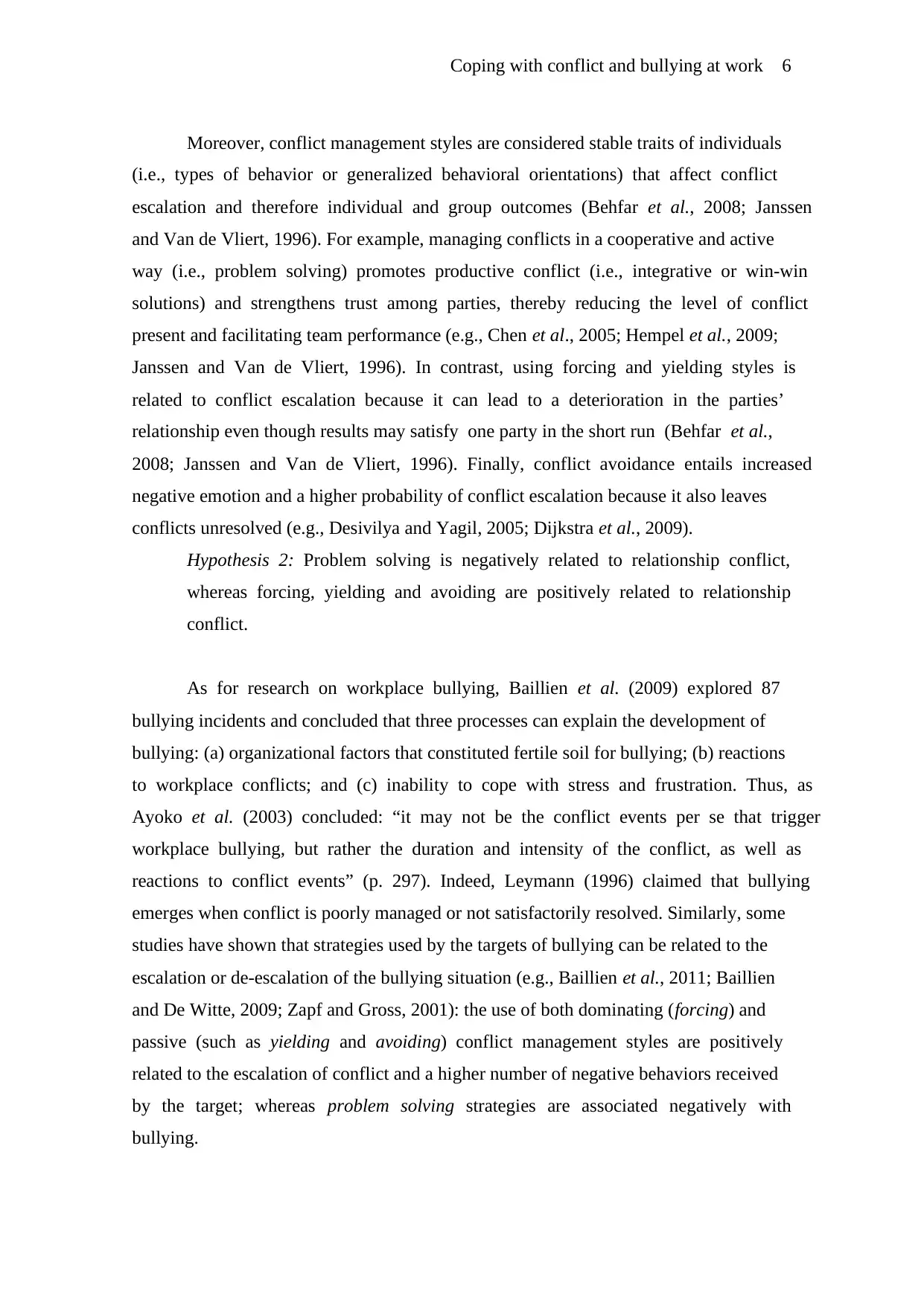
Coping with conflict and bullying at work 6
Moreover, conflict management styles are considered stable traits of individuals
(i.e., types of behavior or generalized behavioral orientations) that affect conflict
escalation and therefore individual and group outcomes (Behfar et al., 2008; Janssen
and Van de Vliert, 1996). For example, managing conflicts in a cooperative and active
way (i.e., problem solving) promotes productive conflict (i.e., integrative or win-win
solutions) and strengthens trust among parties, thereby reducing the level of conflict
present and facilitating team performance (e.g., Chen et al., 2005; Hempel et al., 2009;
Janssen and Van de Vliert, 1996). In contrast, using forcing and yielding styles is
related to conflict escalation because it can lead to a deterioration in the parties’
relationship even though results may satisfy one party in the short run (Behfar et al.,
2008; Janssen and Van de Vliert, 1996). Finally, conflict avoidance entails increased
negative emotion and a higher probability of conflict escalation because it also leaves
conflicts unresolved (e.g., Desivilya and Yagil, 2005; Dijkstra et al., 2009).
Hypothesis 2: Problem solving is negatively related to relationship conflict,
whereas forcing, yielding and avoiding are positively related to relationship
conflict.
As for research on workplace bullying, Baillien et al. (2009) explored 87
bullying incidents and concluded that three processes can explain the development of
bullying: (a) organizational factors that constituted fertile soil for bullying; (b) reactions
to workplace conflicts; and (c) inability to cope with stress and frustration. Thus, as
Ayoko et al. (2003) concluded: “it may not be the conflict events per se that trigger
workplace bullying, but rather the duration and intensity of the conflict, as well as
reactions to conflict events” (p. 297). Indeed, Leymann (1996) claimed that bullying
emerges when conflict is poorly managed or not satisfactorily resolved. Similarly, some
studies have shown that strategies used by the targets of bullying can be related to the
escalation or de-escalation of the bullying situation (e.g., Baillien et al., 2011; Baillien
and De Witte, 2009; Zapf and Gross, 2001): the use of both dominating (forcing) and
passive (such as yielding and avoiding) conflict management styles are positively
related to the escalation of conflict and a higher number of negative behaviors received
by the target; whereas problem solving strategies are associated negatively with
bullying.
Moreover, conflict management styles are considered stable traits of individuals
(i.e., types of behavior or generalized behavioral orientations) that affect conflict
escalation and therefore individual and group outcomes (Behfar et al., 2008; Janssen
and Van de Vliert, 1996). For example, managing conflicts in a cooperative and active
way (i.e., problem solving) promotes productive conflict (i.e., integrative or win-win
solutions) and strengthens trust among parties, thereby reducing the level of conflict
present and facilitating team performance (e.g., Chen et al., 2005; Hempel et al., 2009;
Janssen and Van de Vliert, 1996). In contrast, using forcing and yielding styles is
related to conflict escalation because it can lead to a deterioration in the parties’
relationship even though results may satisfy one party in the short run (Behfar et al.,
2008; Janssen and Van de Vliert, 1996). Finally, conflict avoidance entails increased
negative emotion and a higher probability of conflict escalation because it also leaves
conflicts unresolved (e.g., Desivilya and Yagil, 2005; Dijkstra et al., 2009).
Hypothesis 2: Problem solving is negatively related to relationship conflict,
whereas forcing, yielding and avoiding are positively related to relationship
conflict.
As for research on workplace bullying, Baillien et al. (2009) explored 87
bullying incidents and concluded that three processes can explain the development of
bullying: (a) organizational factors that constituted fertile soil for bullying; (b) reactions
to workplace conflicts; and (c) inability to cope with stress and frustration. Thus, as
Ayoko et al. (2003) concluded: “it may not be the conflict events per se that trigger
workplace bullying, but rather the duration and intensity of the conflict, as well as
reactions to conflict events” (p. 297). Indeed, Leymann (1996) claimed that bullying
emerges when conflict is poorly managed or not satisfactorily resolved. Similarly, some
studies have shown that strategies used by the targets of bullying can be related to the
escalation or de-escalation of the bullying situation (e.g., Baillien et al., 2011; Baillien
and De Witte, 2009; Zapf and Gross, 2001): the use of both dominating (forcing) and
passive (such as yielding and avoiding) conflict management styles are positively
related to the escalation of conflict and a higher number of negative behaviors received
by the target; whereas problem solving strategies are associated negatively with
bullying.
⊘ This is a preview!⊘
Do you want full access?
Subscribe today to unlock all pages.

Trusted by 1+ million students worldwide
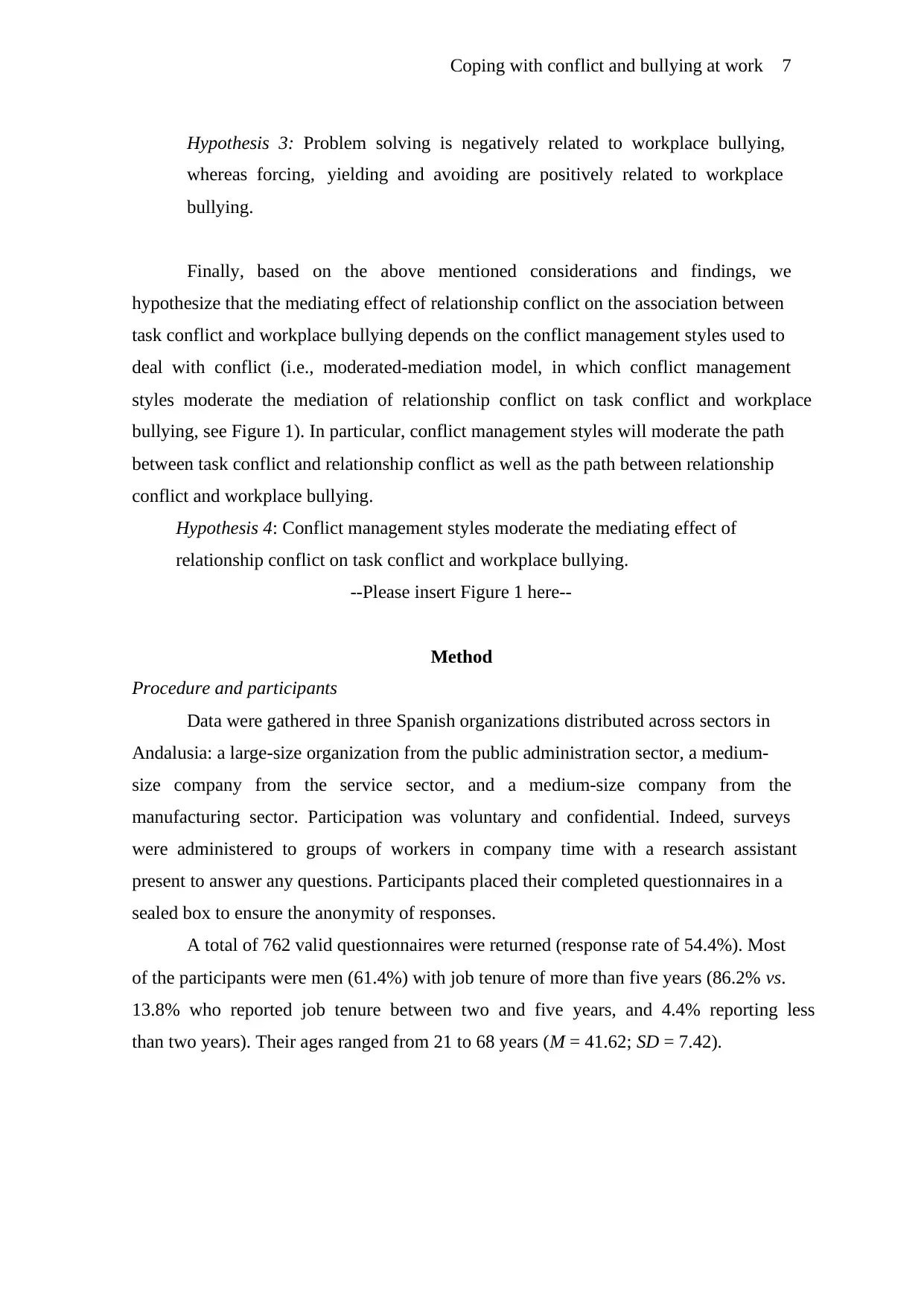
Coping with conflict and bullying at work 7
Hypothesis 3: Problem solving is negatively related to workplace bullying,
whereas forcing, yielding and avoiding are positively related to workplace
bullying.
Finally, based on the above mentioned considerations and findings, we
hypothesize that the mediating effect of relationship conflict on the association between
task conflict and workplace bullying depends on the conflict management styles used to
deal with conflict (i.e., moderated-mediation model, in which conflict management
styles moderate the mediation of relationship conflict on task conflict and workplace
bullying, see Figure 1). In particular, conflict management styles will moderate the path
between task conflict and relationship conflict as well as the path between relationship
conflict and workplace bullying.
Hypothesis 4: Conflict management styles moderate the mediating effect of
relationship conflict on task conflict and workplace bullying.
--Please insert Figure 1 here--
Method
Procedure and participants
Data were gathered in three Spanish organizations distributed across sectors in
Andalusia: a large-size organization from the public administration sector, a medium-
size company from the service sector, and a medium-size company from the
manufacturing sector. Participation was voluntary and confidential. Indeed, surveys
were administered to groups of workers in company time with a research assistant
present to answer any questions. Participants placed their completed questionnaires in a
sealed box to ensure the anonymity of responses.
A total of 762 valid questionnaires were returned (response rate of 54.4%). Most
of the participants were men (61.4%) with job tenure of more than five years (86.2% vs.
13.8% who reported job tenure between two and five years, and 4.4% reporting less
than two years). Their ages ranged from 21 to 68 years (M = 41.62; SD = 7.42).
Hypothesis 3: Problem solving is negatively related to workplace bullying,
whereas forcing, yielding and avoiding are positively related to workplace
bullying.
Finally, based on the above mentioned considerations and findings, we
hypothesize that the mediating effect of relationship conflict on the association between
task conflict and workplace bullying depends on the conflict management styles used to
deal with conflict (i.e., moderated-mediation model, in which conflict management
styles moderate the mediation of relationship conflict on task conflict and workplace
bullying, see Figure 1). In particular, conflict management styles will moderate the path
between task conflict and relationship conflict as well as the path between relationship
conflict and workplace bullying.
Hypothesis 4: Conflict management styles moderate the mediating effect of
relationship conflict on task conflict and workplace bullying.
--Please insert Figure 1 here--
Method
Procedure and participants
Data were gathered in three Spanish organizations distributed across sectors in
Andalusia: a large-size organization from the public administration sector, a medium-
size company from the service sector, and a medium-size company from the
manufacturing sector. Participation was voluntary and confidential. Indeed, surveys
were administered to groups of workers in company time with a research assistant
present to answer any questions. Participants placed their completed questionnaires in a
sealed box to ensure the anonymity of responses.
A total of 762 valid questionnaires were returned (response rate of 54.4%). Most
of the participants were men (61.4%) with job tenure of more than five years (86.2% vs.
13.8% who reported job tenure between two and five years, and 4.4% reporting less
than two years). Their ages ranged from 21 to 68 years (M = 41.62; SD = 7.42).
Paraphrase This Document
Need a fresh take? Get an instant paraphrase of this document with our AI Paraphraser
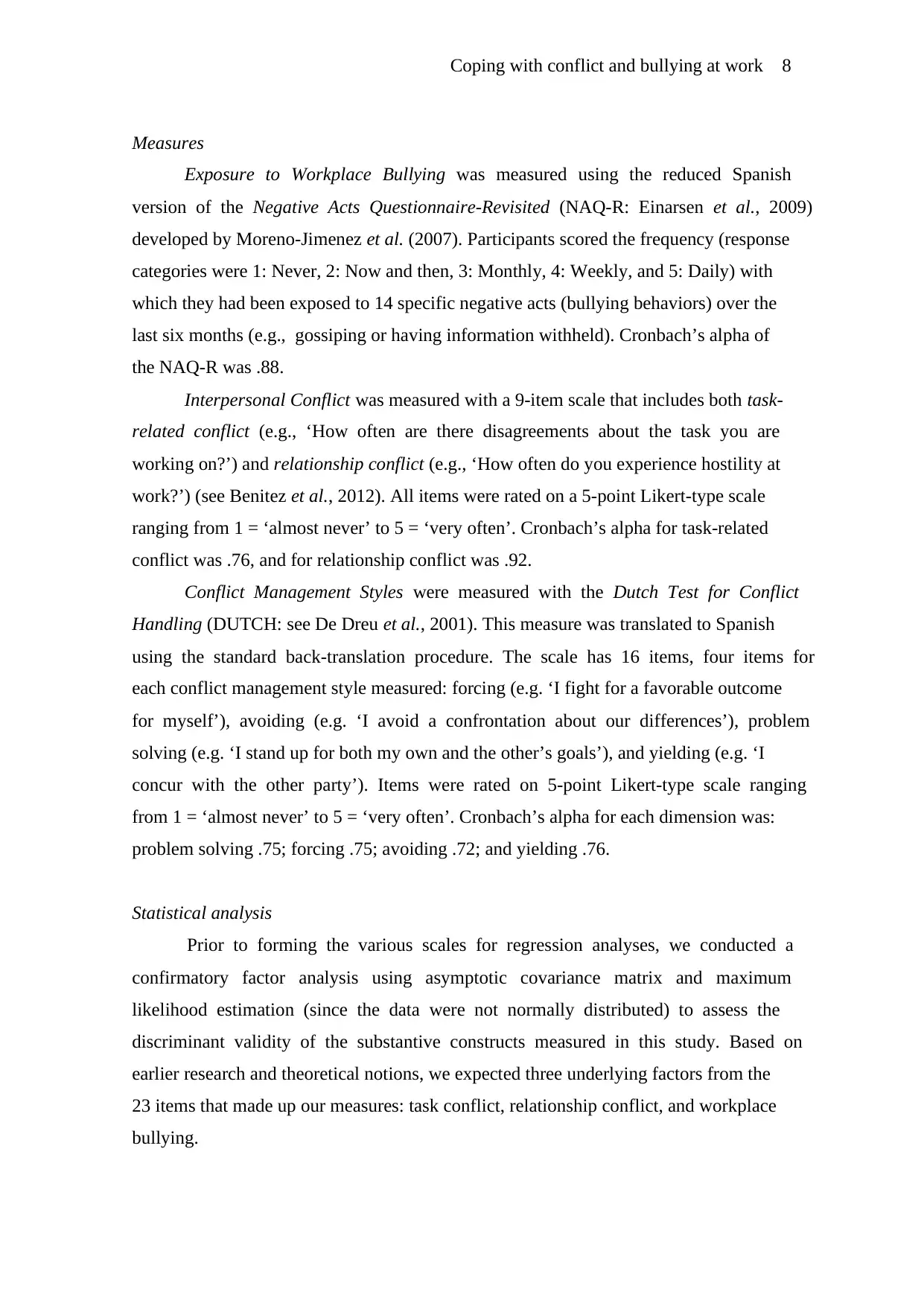
Coping with conflict and bullying at work 8
Measures
Exposure to Workplace Bullying was measured using the reduced Spanish
version of the Negative Acts Questionnaire-Revisited (NAQ-R: Einarsen et al., 2009)
developed by Moreno-Jimenez et al. (2007). Participants scored the frequency (response
categories were 1: Never, 2: Now and then, 3: Monthly, 4: Weekly, and 5: Daily) with
which they had been exposed to 14 specific negative acts (bullying behaviors) over the
last six months (e.g., gossiping or having information withheld). Cronbach’s alpha of
the NAQ-R was .88.
Interpersonal Conflict was measured with a 9-item scale that includes both task-
related conflict (e.g., ‘How often are there disagreements about the task you are
working on?’) and relationship conflict (e.g., ‘How often do you experience hostility at
work?’) (see Benitez et al., 2012). All items were rated on a 5-point Likert-type scale
ranging from 1 = ‘almost never’ to 5 = ‘very often’. Cronbach’s alpha for task-related
conflict was .76, and for relationship conflict was .92.
Conflict Management Styles were measured with the Dutch Test for Conflict
Handling (DUTCH: see De Dreu et al., 2001). This measure was translated to Spanish
using the standard back-translation procedure. The scale has 16 items, four items for
each conflict management style measured: forcing (e.g. ‘I fight for a favorable outcome
for myself’), avoiding (e.g. ‘I avoid a confrontation about our differences’), problem
solving (e.g. ‘I stand up for both my own and the other’s goals’), and yielding (e.g. ‘I
concur with the other party’). Items were rated on 5-point Likert-type scale ranging
from 1 = ‘almost never’ to 5 = ‘very often’. Cronbach’s alpha for each dimension was:
problem solving .75; forcing .75; avoiding .72; and yielding .76.
Statistical analysis
Prior to forming the various scales for regression analyses, we conducted a
confirmatory factor analysis using asymptotic covariance matrix and maximum
likelihood estimation (since the data were not normally distributed) to assess the
discriminant validity of the substantive constructs measured in this study. Based on
earlier research and theoretical notions, we expected three underlying factors from the
23 items that made up our measures: task conflict, relationship conflict, and workplace
bullying.
Measures
Exposure to Workplace Bullying was measured using the reduced Spanish
version of the Negative Acts Questionnaire-Revisited (NAQ-R: Einarsen et al., 2009)
developed by Moreno-Jimenez et al. (2007). Participants scored the frequency (response
categories were 1: Never, 2: Now and then, 3: Monthly, 4: Weekly, and 5: Daily) with
which they had been exposed to 14 specific negative acts (bullying behaviors) over the
last six months (e.g., gossiping or having information withheld). Cronbach’s alpha of
the NAQ-R was .88.
Interpersonal Conflict was measured with a 9-item scale that includes both task-
related conflict (e.g., ‘How often are there disagreements about the task you are
working on?’) and relationship conflict (e.g., ‘How often do you experience hostility at
work?’) (see Benitez et al., 2012). All items were rated on a 5-point Likert-type scale
ranging from 1 = ‘almost never’ to 5 = ‘very often’. Cronbach’s alpha for task-related
conflict was .76, and for relationship conflict was .92.
Conflict Management Styles were measured with the Dutch Test for Conflict
Handling (DUTCH: see De Dreu et al., 2001). This measure was translated to Spanish
using the standard back-translation procedure. The scale has 16 items, four items for
each conflict management style measured: forcing (e.g. ‘I fight for a favorable outcome
for myself’), avoiding (e.g. ‘I avoid a confrontation about our differences’), problem
solving (e.g. ‘I stand up for both my own and the other’s goals’), and yielding (e.g. ‘I
concur with the other party’). Items were rated on 5-point Likert-type scale ranging
from 1 = ‘almost never’ to 5 = ‘very often’. Cronbach’s alpha for each dimension was:
problem solving .75; forcing .75; avoiding .72; and yielding .76.
Statistical analysis
Prior to forming the various scales for regression analyses, we conducted a
confirmatory factor analysis using asymptotic covariance matrix and maximum
likelihood estimation (since the data were not normally distributed) to assess the
discriminant validity of the substantive constructs measured in this study. Based on
earlier research and theoretical notions, we expected three underlying factors from the
23 items that made up our measures: task conflict, relationship conflict, and workplace
bullying.
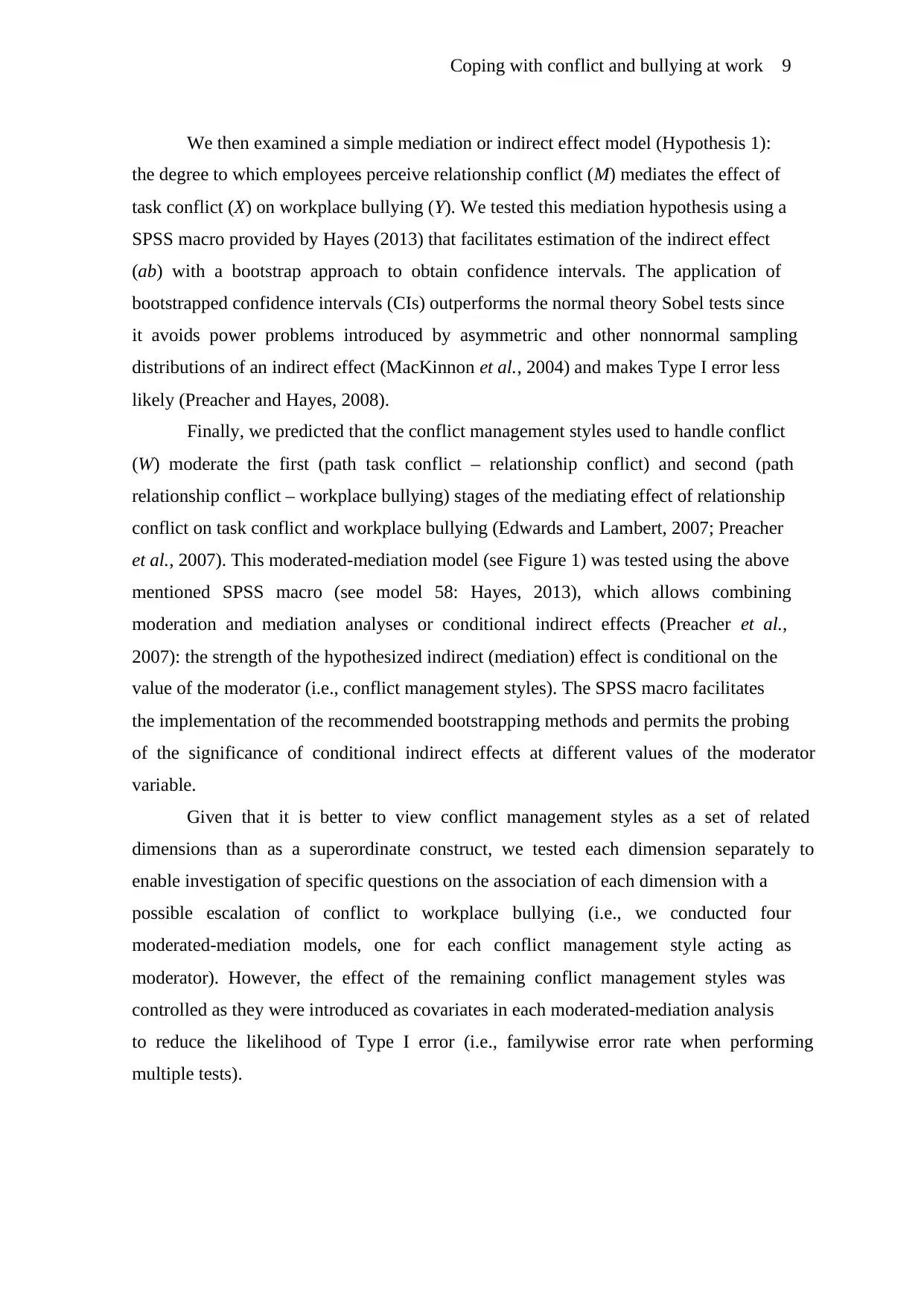
Coping with conflict and bullying at work 9
We then examined a simple mediation or indirect effect model (Hypothesis 1):
the degree to which employees perceive relationship conflict (M) mediates the effect of
task conflict (X) on workplace bullying (Y). We tested this mediation hypothesis using a
SPSS macro provided by Hayes (2013) that facilitates estimation of the indirect effect
(ab) with a bootstrap approach to obtain confidence intervals. The application of
bootstrapped confidence intervals (CIs) outperforms the normal theory Sobel tests since
it avoids power problems introduced by asymmetric and other nonnormal sampling
distributions of an indirect effect (MacKinnon et al., 2004) and makes Type I error less
likely (Preacher and Hayes, 2008).
Finally, we predicted that the conflict management styles used to handle conflict
(W) moderate the first (path task conflict – relationship conflict) and second (path
relationship conflict – workplace bullying) stages of the mediating effect of relationship
conflict on task conflict and workplace bullying (Edwards and Lambert, 2007; Preacher
et al., 2007). This moderated-mediation model (see Figure 1) was tested using the above
mentioned SPSS macro (see model 58: Hayes, 2013), which allows combining
moderation and mediation analyses or conditional indirect effects (Preacher et al.,
2007): the strength of the hypothesized indirect (mediation) effect is conditional on the
value of the moderator (i.e., conflict management styles). The SPSS macro facilitates
the implementation of the recommended bootstrapping methods and permits the probing
of the significance of conditional indirect effects at different values of the moderator
variable.
Given that it is better to view conflict management styles as a set of related
dimensions than as a superordinate construct, we tested each dimension separately to
enable investigation of specific questions on the association of each dimension with a
possible escalation of conflict to workplace bullying (i.e., we conducted four
moderated-mediation models, one for each conflict management style acting as
moderator). However, the effect of the remaining conflict management styles was
controlled as they were introduced as covariates in each moderated-mediation analysis
to reduce the likelihood of Type I error (i.e., familywise error rate when performing
multiple tests).
We then examined a simple mediation or indirect effect model (Hypothesis 1):
the degree to which employees perceive relationship conflict (M) mediates the effect of
task conflict (X) on workplace bullying (Y). We tested this mediation hypothesis using a
SPSS macro provided by Hayes (2013) that facilitates estimation of the indirect effect
(ab) with a bootstrap approach to obtain confidence intervals. The application of
bootstrapped confidence intervals (CIs) outperforms the normal theory Sobel tests since
it avoids power problems introduced by asymmetric and other nonnormal sampling
distributions of an indirect effect (MacKinnon et al., 2004) and makes Type I error less
likely (Preacher and Hayes, 2008).
Finally, we predicted that the conflict management styles used to handle conflict
(W) moderate the first (path task conflict – relationship conflict) and second (path
relationship conflict – workplace bullying) stages of the mediating effect of relationship
conflict on task conflict and workplace bullying (Edwards and Lambert, 2007; Preacher
et al., 2007). This moderated-mediation model (see Figure 1) was tested using the above
mentioned SPSS macro (see model 58: Hayes, 2013), which allows combining
moderation and mediation analyses or conditional indirect effects (Preacher et al.,
2007): the strength of the hypothesized indirect (mediation) effect is conditional on the
value of the moderator (i.e., conflict management styles). The SPSS macro facilitates
the implementation of the recommended bootstrapping methods and permits the probing
of the significance of conditional indirect effects at different values of the moderator
variable.
Given that it is better to view conflict management styles as a set of related
dimensions than as a superordinate construct, we tested each dimension separately to
enable investigation of specific questions on the association of each dimension with a
possible escalation of conflict to workplace bullying (i.e., we conducted four
moderated-mediation models, one for each conflict management style acting as
moderator). However, the effect of the remaining conflict management styles was
controlled as they were introduced as covariates in each moderated-mediation analysis
to reduce the likelihood of Type I error (i.e., familywise error rate when performing
multiple tests).
⊘ This is a preview!⊘
Do you want full access?
Subscribe today to unlock all pages.

Trusted by 1+ million students worldwide
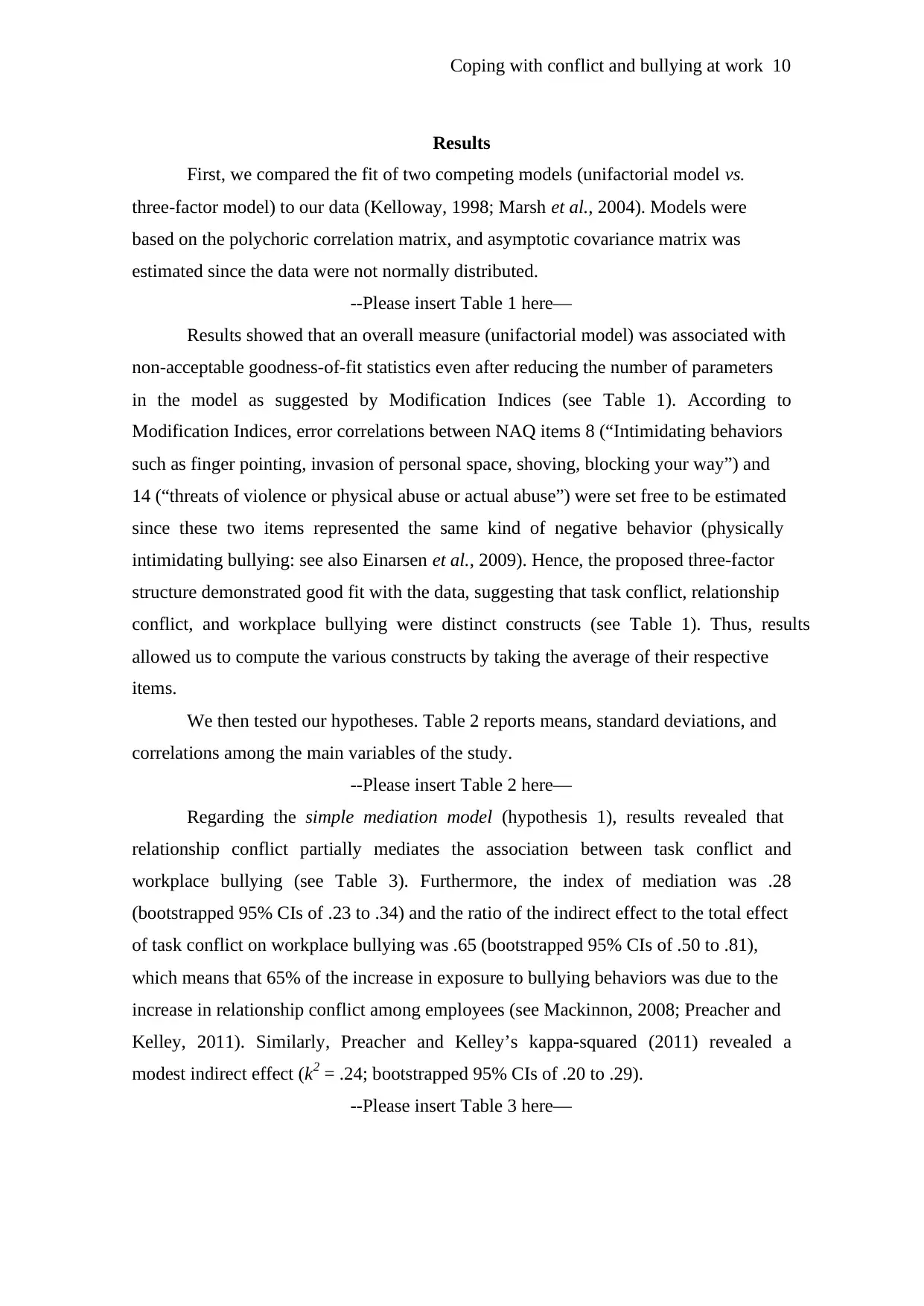
Coping with conflict and bullying at work 10
Results
First, we compared the fit of two competing models (unifactorial model vs.
three-factor model) to our data (Kelloway, 1998; Marsh et al., 2004). Models were
based on the polychoric correlation matrix, and asymptotic covariance matrix was
estimated since the data were not normally distributed.
--Please insert Table 1 here—
Results showed that an overall measure (unifactorial model) was associated with
non-acceptable goodness-of-fit statistics even after reducing the number of parameters
in the model as suggested by Modification Indices (see Table 1). According to
Modification Indices, error correlations between NAQ items 8 (“Intimidating behaviors
such as finger pointing, invasion of personal space, shoving, blocking your way”) and
14 (“threats of violence or physical abuse or actual abuse”) were set free to be estimated
since these two items represented the same kind of negative behavior (physically
intimidating bullying: see also Einarsen et al., 2009). Hence, the proposed three-factor
structure demonstrated good fit with the data, suggesting that task conflict, relationship
conflict, and workplace bullying were distinct constructs (see Table 1). Thus, results
allowed us to compute the various constructs by taking the average of their respective
items.
We then tested our hypotheses. Table 2 reports means, standard deviations, and
correlations among the main variables of the study.
--Please insert Table 2 here—
Regarding the simple mediation model (hypothesis 1), results revealed that
relationship conflict partially mediates the association between task conflict and
workplace bullying (see Table 3). Furthermore, the index of mediation was .28
(bootstrapped 95% CIs of .23 to .34) and the ratio of the indirect effect to the total effect
of task conflict on workplace bullying was .65 (bootstrapped 95% CIs of .50 to .81),
which means that 65% of the increase in exposure to bullying behaviors was due to the
increase in relationship conflict among employees (see Mackinnon, 2008; Preacher and
Kelley, 2011). Similarly, Preacher and Kelley’s kappa-squared (2011) revealed a
modest indirect effect (k2 = .24; bootstrapped 95% CIs of .20 to .29).
--Please insert Table 3 here—
Results
First, we compared the fit of two competing models (unifactorial model vs.
three-factor model) to our data (Kelloway, 1998; Marsh et al., 2004). Models were
based on the polychoric correlation matrix, and asymptotic covariance matrix was
estimated since the data were not normally distributed.
--Please insert Table 1 here—
Results showed that an overall measure (unifactorial model) was associated with
non-acceptable goodness-of-fit statistics even after reducing the number of parameters
in the model as suggested by Modification Indices (see Table 1). According to
Modification Indices, error correlations between NAQ items 8 (“Intimidating behaviors
such as finger pointing, invasion of personal space, shoving, blocking your way”) and
14 (“threats of violence or physical abuse or actual abuse”) were set free to be estimated
since these two items represented the same kind of negative behavior (physically
intimidating bullying: see also Einarsen et al., 2009). Hence, the proposed three-factor
structure demonstrated good fit with the data, suggesting that task conflict, relationship
conflict, and workplace bullying were distinct constructs (see Table 1). Thus, results
allowed us to compute the various constructs by taking the average of their respective
items.
We then tested our hypotheses. Table 2 reports means, standard deviations, and
correlations among the main variables of the study.
--Please insert Table 2 here—
Regarding the simple mediation model (hypothesis 1), results revealed that
relationship conflict partially mediates the association between task conflict and
workplace bullying (see Table 3). Furthermore, the index of mediation was .28
(bootstrapped 95% CIs of .23 to .34) and the ratio of the indirect effect to the total effect
of task conflict on workplace bullying was .65 (bootstrapped 95% CIs of .50 to .81),
which means that 65% of the increase in exposure to bullying behaviors was due to the
increase in relationship conflict among employees (see Mackinnon, 2008; Preacher and
Kelley, 2011). Similarly, Preacher and Kelley’s kappa-squared (2011) revealed a
modest indirect effect (k2 = .24; bootstrapped 95% CIs of .20 to .29).
--Please insert Table 3 here—
Paraphrase This Document
Need a fresh take? Get an instant paraphrase of this document with our AI Paraphraser
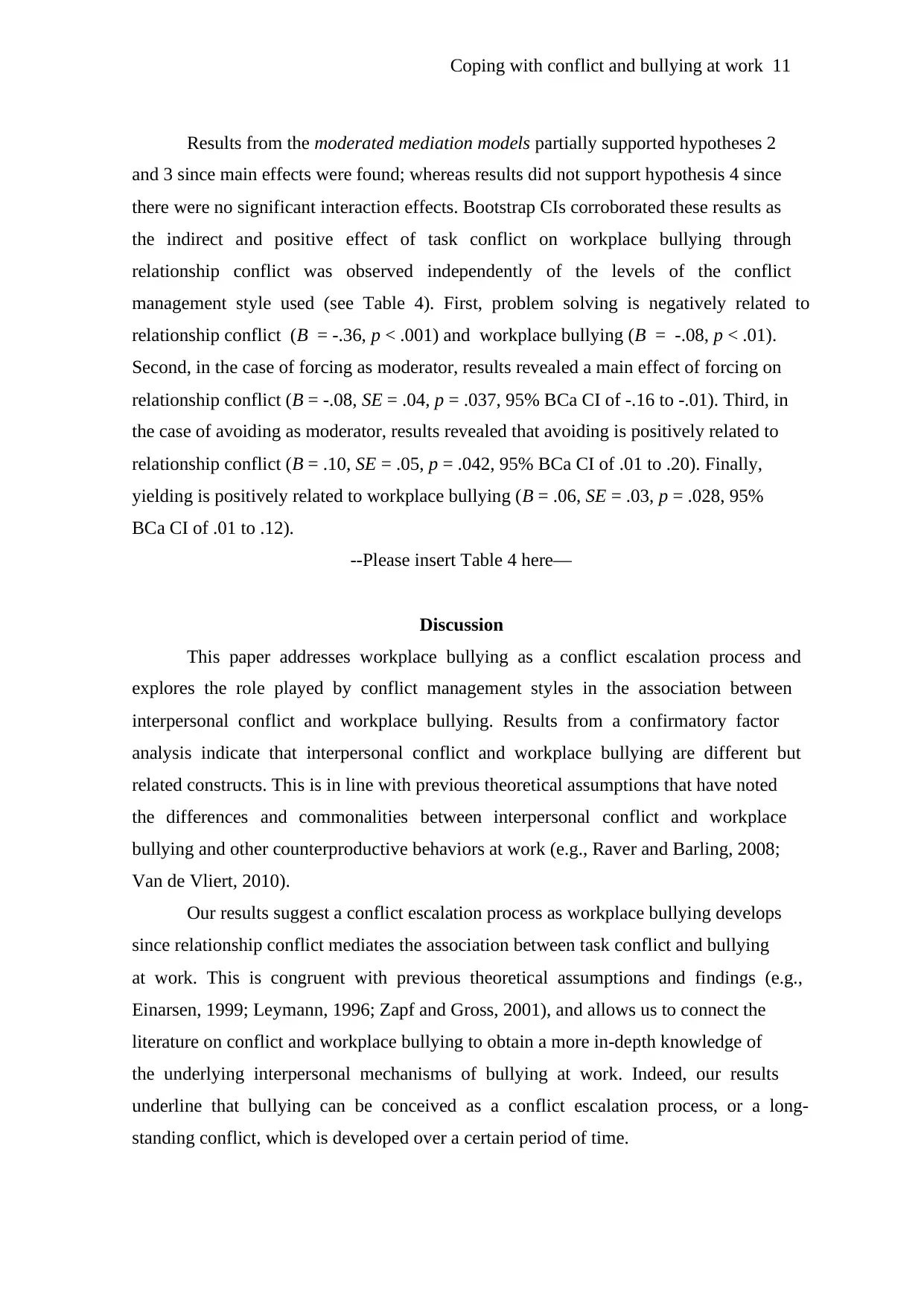
Coping with conflict and bullying at work 11
Results from the moderated mediation models partially supported hypotheses 2
and 3 since main effects were found; whereas results did not support hypothesis 4 since
there were no significant interaction effects. Bootstrap CIs corroborated these results as
the indirect and positive effect of task conflict on workplace bullying through
relationship conflict was observed independently of the levels of the conflict
management style used (see Table 4). First, problem solving is negatively related to
relationship conflict (B = -.36, p < .001) and workplace bullying (B = -.08, p < .01).
Second, in the case of forcing as moderator, results revealed a main effect of forcing on
relationship conflict (B = -.08, SE = .04, p = .037, 95% BCa CI of -.16 to -.01). Third, in
the case of avoiding as moderator, results revealed that avoiding is positively related to
relationship conflict (B = .10, SE = .05, p = .042, 95% BCa CI of .01 to .20). Finally,
yielding is positively related to workplace bullying (B = .06, SE = .03, p = .028, 95%
BCa CI of .01 to .12).
--Please insert Table 4 here—
Discussion
This paper addresses workplace bullying as a conflict escalation process and
explores the role played by conflict management styles in the association between
interpersonal conflict and workplace bullying. Results from a confirmatory factor
analysis indicate that interpersonal conflict and workplace bullying are different but
related constructs. This is in line with previous theoretical assumptions that have noted
the differences and commonalities between interpersonal conflict and workplace
bullying and other counterproductive behaviors at work (e.g., Raver and Barling, 2008;
Van de Vliert, 2010).
Our results suggest a conflict escalation process as workplace bullying develops
since relationship conflict mediates the association between task conflict and bullying
at work. This is congruent with previous theoretical assumptions and findings (e.g.,
Einarsen, 1999; Leymann, 1996; Zapf and Gross, 2001), and allows us to connect the
literature on conflict and workplace bullying to obtain a more in-depth knowledge of
the underlying interpersonal mechanisms of bullying at work. Indeed, our results
underline that bullying can be conceived as a conflict escalation process, or a long-
standing conflict, which is developed over a certain period of time.
Results from the moderated mediation models partially supported hypotheses 2
and 3 since main effects were found; whereas results did not support hypothesis 4 since
there were no significant interaction effects. Bootstrap CIs corroborated these results as
the indirect and positive effect of task conflict on workplace bullying through
relationship conflict was observed independently of the levels of the conflict
management style used (see Table 4). First, problem solving is negatively related to
relationship conflict (B = -.36, p < .001) and workplace bullying (B = -.08, p < .01).
Second, in the case of forcing as moderator, results revealed a main effect of forcing on
relationship conflict (B = -.08, SE = .04, p = .037, 95% BCa CI of -.16 to -.01). Third, in
the case of avoiding as moderator, results revealed that avoiding is positively related to
relationship conflict (B = .10, SE = .05, p = .042, 95% BCa CI of .01 to .20). Finally,
yielding is positively related to workplace bullying (B = .06, SE = .03, p = .028, 95%
BCa CI of .01 to .12).
--Please insert Table 4 here—
Discussion
This paper addresses workplace bullying as a conflict escalation process and
explores the role played by conflict management styles in the association between
interpersonal conflict and workplace bullying. Results from a confirmatory factor
analysis indicate that interpersonal conflict and workplace bullying are different but
related constructs. This is in line with previous theoretical assumptions that have noted
the differences and commonalities between interpersonal conflict and workplace
bullying and other counterproductive behaviors at work (e.g., Raver and Barling, 2008;
Van de Vliert, 2010).
Our results suggest a conflict escalation process as workplace bullying develops
since relationship conflict mediates the association between task conflict and bullying
at work. This is congruent with previous theoretical assumptions and findings (e.g.,
Einarsen, 1999; Leymann, 1996; Zapf and Gross, 2001), and allows us to connect the
literature on conflict and workplace bullying to obtain a more in-depth knowledge of
the underlying interpersonal mechanisms of bullying at work. Indeed, our results
underline that bullying can be conceived as a conflict escalation process, or a long-
standing conflict, which is developed over a certain period of time.
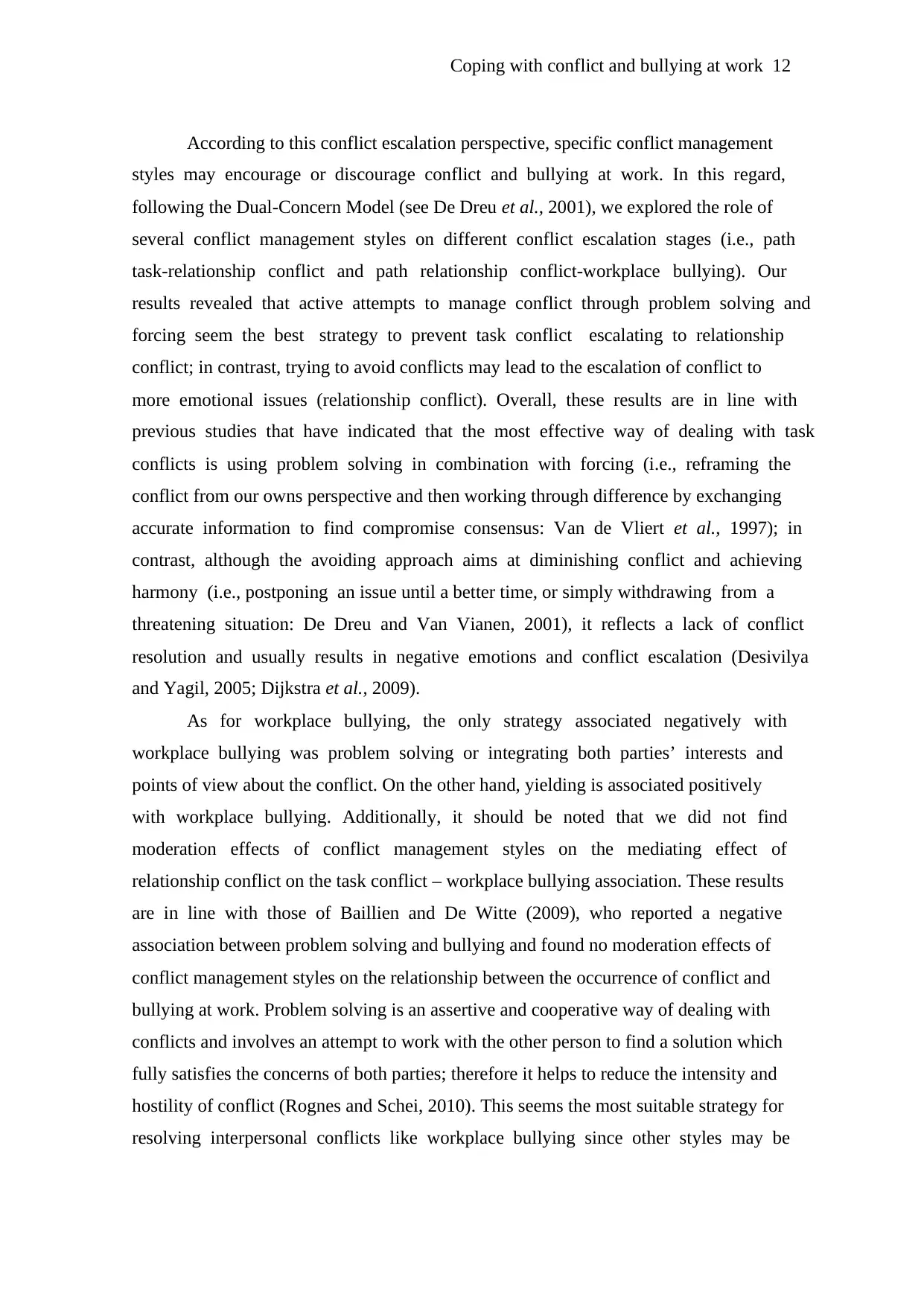
Coping with conflict and bullying at work 12
According to this conflict escalation perspective, specific conflict management
styles may encourage or discourage conflict and bullying at work. In this regard,
following the Dual-Concern Model (see De Dreu et al., 2001), we explored the role of
several conflict management styles on different conflict escalation stages (i.e., path
task-relationship conflict and path relationship conflict-workplace bullying). Our
results revealed that active attempts to manage conflict through problem solving and
forcing seem the best strategy to prevent task conflict escalating to relationship
conflict; in contrast, trying to avoid conflicts may lead to the escalation of conflict to
more emotional issues (relationship conflict). Overall, these results are in line with
previous studies that have indicated that the most effective way of dealing with task
conflicts is using problem solving in combination with forcing (i.e., reframing the
conflict from our owns perspective and then working through difference by exchanging
accurate information to find compromise consensus: Van de Vliert et al., 1997); in
contrast, although the avoiding approach aims at diminishing conflict and achieving
harmony (i.e., postponing an issue until a better time, or simply withdrawing from a
threatening situation: De Dreu and Van Vianen, 2001), it reflects a lack of conflict
resolution and usually results in negative emotions and conflict escalation (Desivilya
and Yagil, 2005; Dijkstra et al., 2009).
As for workplace bullying, the only strategy associated negatively with
workplace bullying was problem solving or integrating both parties’ interests and
points of view about the conflict. On the other hand, yielding is associated positively
with workplace bullying. Additionally, it should be noted that we did not find
moderation effects of conflict management styles on the mediating effect of
relationship conflict on the task conflict – workplace bullying association. These results
are in line with those of Baillien and De Witte (2009), who reported a negative
association between problem solving and bullying and found no moderation effects of
conflict management styles on the relationship between the occurrence of conflict and
bullying at work. Problem solving is an assertive and cooperative way of dealing with
conflicts and involves an attempt to work with the other person to find a solution which
fully satisfies the concerns of both parties; therefore it helps to reduce the intensity and
hostility of conflict (Rognes and Schei, 2010). This seems the most suitable strategy for
resolving interpersonal conflicts like workplace bullying since other styles may be
According to this conflict escalation perspective, specific conflict management
styles may encourage or discourage conflict and bullying at work. In this regard,
following the Dual-Concern Model (see De Dreu et al., 2001), we explored the role of
several conflict management styles on different conflict escalation stages (i.e., path
task-relationship conflict and path relationship conflict-workplace bullying). Our
results revealed that active attempts to manage conflict through problem solving and
forcing seem the best strategy to prevent task conflict escalating to relationship
conflict; in contrast, trying to avoid conflicts may lead to the escalation of conflict to
more emotional issues (relationship conflict). Overall, these results are in line with
previous studies that have indicated that the most effective way of dealing with task
conflicts is using problem solving in combination with forcing (i.e., reframing the
conflict from our owns perspective and then working through difference by exchanging
accurate information to find compromise consensus: Van de Vliert et al., 1997); in
contrast, although the avoiding approach aims at diminishing conflict and achieving
harmony (i.e., postponing an issue until a better time, or simply withdrawing from a
threatening situation: De Dreu and Van Vianen, 2001), it reflects a lack of conflict
resolution and usually results in negative emotions and conflict escalation (Desivilya
and Yagil, 2005; Dijkstra et al., 2009).
As for workplace bullying, the only strategy associated negatively with
workplace bullying was problem solving or integrating both parties’ interests and
points of view about the conflict. On the other hand, yielding is associated positively
with workplace bullying. Additionally, it should be noted that we did not find
moderation effects of conflict management styles on the mediating effect of
relationship conflict on the task conflict – workplace bullying association. These results
are in line with those of Baillien and De Witte (2009), who reported a negative
association between problem solving and bullying and found no moderation effects of
conflict management styles on the relationship between the occurrence of conflict and
bullying at work. Problem solving is an assertive and cooperative way of dealing with
conflicts and involves an attempt to work with the other person to find a solution which
fully satisfies the concerns of both parties; therefore it helps to reduce the intensity and
hostility of conflict (Rognes and Schei, 2010). This seems the most suitable strategy for
resolving interpersonal conflicts like workplace bullying since other styles may be
⊘ This is a preview!⊘
Do you want full access?
Subscribe today to unlock all pages.

Trusted by 1+ million students worldwide
1 out of 22
Your All-in-One AI-Powered Toolkit for Academic Success.
+13062052269
info@desklib.com
Available 24*7 on WhatsApp / Email
![[object Object]](/_next/static/media/star-bottom.7253800d.svg)
Unlock your academic potential
Copyright © 2020–2025 A2Z Services. All Rights Reserved. Developed and managed by ZUCOL.

